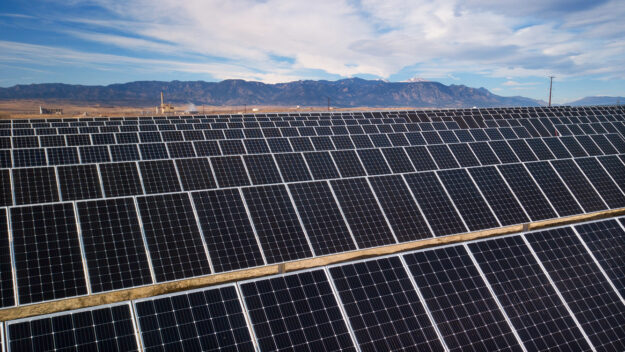Widgetized Section
Go to Admin » Appearance » Widgets » and move Gabfire Widget: Social into that MastheadOverlay zone
Holy Cross, Xcel Energy explore power storage options in push to deliver 100% renewable energy

Holy Cross Energy aims to distribute 100% emission-free electricity to its 55,000 members in the Aspen, Rifle, and Vail areas by 2030. How will it do that?

Tri-State Generation and Transmission, Colorado’s second largest utility, has a different but related problem. It wants to best use infrastructure associated with its coal-burning operations at Craig after the last unit closes before 2030.
One clue may lie in Pueblo. There a pilot program testing a new technology for long-duration energy storage will be deployed by Xcel Energy and Form Energy by the end of 2025. The new iron-air batteries will be able to use chemical processes to store electricity and then discharge it for up to 100 hours.
The new battery technology has been reported to be 10 times less expensive than lithium-ion batteries. Iron is abundant in the United States, and the batteries are non-flammable.
In announcing the pilot projects, Bob Frenzel, the chief executive of Xcel, said the 100-hour batteries at Pueblo and at a coal site in Minnesota “will strengthen the grid against normal day-to-day, week-to-week, and season-to-season weather variability, in addition to extreme weather events, including severe winter storms and polar vortex events.”
Duration of storage matters entirely as electric utilities add low-cost and emissions-free renewables. Short-duration storage, such as the lithium-ion batteries installed in conjunction with a new solar farm near Glenwood Springs in 2022, can help. They provide two to four hours of storage.
With 100 hours of storage, utilities can smooth the highs and the lows of renewables. Consider Uri, the week of cold in 2022 when wind on Colorado’s eastern plains ceased for several days. Utilities cranked up turbines burning natural gas that was suddenly in high demand. Consumers are still paying off those bills. Tri-State even resorted to burning oil.
Summers have brought inverse problems of spiking demand caused by heat. In 2021, it got so hot in Portland that electric lines for trains melted, and some people without air conditioning literally baked to death in apartments. Colorado regulators worry whether the state’s utilities can handle such weather extremes.
Iron-air batteries alone are unlikely to solve the intermittencies of renewable energy or the havoc produced by a warming and more erratic climate. This pilot project does represent a notable effort to explore whether they can be scaled.
“This is an exciting new frontier for energy storage in Colorado,” said Mike Kruger, chief executive of the Colorado Solar and Storage Association, a trade group of 275 members. “This announcement goes to show that when there is clear policy, American companies can innovate to meet the electric power sector’s needs.”
Holy Cross Energy has been diversifying its supplies, both locally and regionally, but still depends largely upon wholesale deliveries from Xcel. The Glenwood Springs-based cooperative in 2022 delivered 50% emissions free electricity but has a goal of 100% just seven years from now.
Sam Whelan, the vice president for finance at Holy Cross, said that increased reliability by Xcel will help Holy Cross reliably deliver electricity to its members.
Holy Cross has been investigating its own options—and has had conversations with Form Energy. It will look at many alternatives, including green hydrogen and pumped-storage hydro, each with problems but also promise.
“You have to start something, and you have to start in small increments as well,” says Whelan.
The solar industry, he says, also started small. “It was not that long ago that solar costs were significantly higher,” he observed. Now, solar has become competitive. “It will take these incremental storage projects to prove out and hopefully pave the way.”
Tri-State, at a recent meeting with stakeholders, also reported that iron-air storage technology was among several options for Craig being studied once the coal plants there close. Transmission lines already exist, capable of carrying renewable energy to the site to be stored – and then released as needed.
Xcel may have gleanings about how they will act at scale and be used to manage the grid by 2026.
Will these new batteries eliminate need for expensive natural gas plants designed for use to meet peak demands? Such plants are expensive to build, and they do produce emissions. Too soon to tell, says Robert Kenney, the president of Xcel Energy’s Colorado division.
“If we see success with this program, we will explore how we can expand it and scale it up further. But to what extent it will displace ‘peaker’ plants or any other technology, that would be the learning that we would expect to come out of the pilot itself. So stay tuned.”
Editor’s note: This story first appeared on Allen Best’s Big Pivots website.
Latest posts by Allen Best, Big Pivots (see all)
- Trump’s Big Beautiful Bill could have an ugly impact on your Colorado electric bill - June 5, 2025
- Analysis: Colorado data center bill raises serious questions of electric consumers subsidizing Big Tech - April 15, 2025
- Hurd, Evans walking fine line on renewable energy as Trump pushes ‘drill, baby, drill’ oil, gas agenda - March 21, 2025


